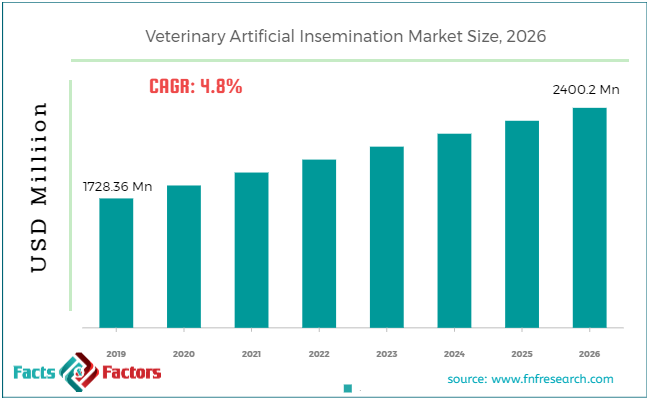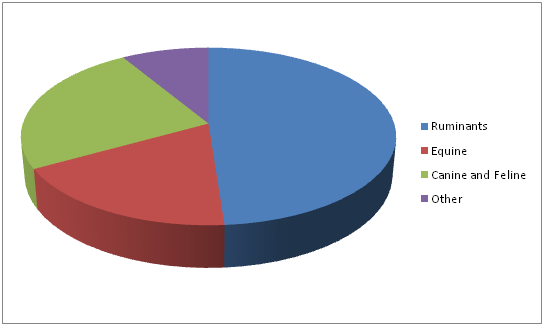Search Market Research Report
Veterinary Artificial Insemination Market Size, Share Global Analysis Report, 2020–2026

Veterinary Artificial Insemination Market By Animal Type (Ruminants, Equine, Canine and Feline and Other), Technique (Intrauterine Tuboperitoneal Insemination, Intracervical Insemination, Intrauterine Insemination, and Intratubal Insemination) and End user (Veterinary Hospitals, Veterinary Clinics and Others)and Regions: Global Industry Outlook, Market Size, Business Intelligence, Consumer Preferences, Statistical Surveys, Comprehensive Analysis, Historical Developments, Current Trends, and Forecast 2020–2026
Industry Insights
According to the report published by Facts & Factors, the global Veterinary Artificial Insemination market size was worth around USD 1728.36 million in 2019 and is predicted to grow around USD 2400.2 million by 2026 with a compound annual growth rate (CAGR) of roughly 4.8% between 2020 and 2026. The report analyzes the global Veterinary Artificial Insemination market drivers, restraints/challenges, and the effect they have on the demands during the projection period. In addition, the report explores emerging opportunities in the Veterinary Artificial Insemination market.
The Veterinary Artificial Insemination Market report analyzes and notifies the industry statistics at the global as well as regional and country levels in order to acquire a thorough perspective of the entire veterinary artificial insemination market. The historical and past insights are provided for FY 2016 to FY 2019 whereas projected trends are delivered for FY 2020 to FY 2026. The quantitative and numerical data is represented in terms of both volume (Units) and value (USD Million) from FY 2016 – 2026.
This specialized and expertise-oriented industry research report scrutinizes the technical and commercial business outlook of the veterinary artificial insemination industry. The report analyzes and declares the historical and current trends analysis of the veterinary artificial insemination industry and subsequently recommends the projected trends anticipated to be observed in the veterinary artificial insemination market during the upcoming years.

 Key Insights from Primary Research
Key Insights from Primary Research
- As per our primary respondents, the global veterinary artificial insemination market is set to grow annually at a rate of around 5%
- It was established through primary research that the global veterinary artificial insemination market was valued at around 1700USD billion in 2019
- The “ruminant” category, on the basis of animal type segmentation, is expected to dominate in terms of revenue, over the forecast period
- Based on the region, the Asia Pacific is expected to account for the revenue share in 2019 in the target market
 Key Recommendations from Analysts
Key Recommendations from Analysts
- As per our analysts, global veterinary artificial insemination are growing at high CAGR and various end-use industries are aware of this potential market and applications of varicose vein treatment
- Growing at a CAGR around 4.8%, global veterinary artificial insemination market provides numerous opportunities for all of the involved stakeholders across the entire value chain
- Our analysts have identified are ruminant dominating segment for global veterinary artificial insemination market in terms of animal type segmentations
 Market Share – By Animal Type
Market Share – By Animal Type

The quantitative data is further underlined and reinforced by comprehensive qualitative data which comprises various across-the-board market dynamics. The rationales which directly or indirectly impact the veterinary artificial insemination industry are exemplified through parameters such as growth drivers, restraints, challenges, and opportunities among other impacting factors.
Throughout our research report, we have encompassed all the proven models and tools of industry analysis and extensively illustrated all the key business strategies and business models adopted in the veterinary artificial insemination industry. The report provides an all-inclusive and detailed competitive landscape prevalent in the veterinary artificial insemination market.
The report utilizes established industry analysis tools and models such as Porter’s Five Forces framework to analyze and recognize critical business strategies adopted by various stakeholders the veterinary artificial insemination involved in the entire value chain of the veterinary artificial insemination industry. The market report additionally employs SWOT analysis and PESTLE analysis models for further in-depth analysis.
The report study further includes an in-depth analysis of industry players' market shares and provides an overview of leading players' market position in the veterinary artificial insemination sector. Key strategic developments in the veterinary artificial insemination market competitive landscape such as acquisitions & mergers, inaugurations of different products and services, partnerships & joint ventures, MoU agreements, VC & funding activities, R&D activities, and geographic expansion among other noteworthy activities by key players of the veterinary artificial insemination market are appropriately highlighted in the report.
Increasing awareness of sexually transmitted diseases in animals to prevent STDs is being used in animals, increasing technological advances; increasing awareness of the protection of endangered species, and increasing the conservation of their species are driving the global market. Artificial insemination, however, is more laborious, and skilled technicians are lacking, associated with high costs.
The veterinary artificial insemination market research report delivers an acute valuation and taxonomy of the veterinary artificial insemination industry by practically splitting the market on the basis of different animal types, techniques, end-user, and regions. Through the analysis of the historical and projected trends, all the segments and sub-segments were evaluated through the bottom-up approach, and different market sizes have been projected for FY 2020 to FY 2026.
The regional segmentation of the veterinary artificial insemination industry includes the complete classification of all the major continents including North America, Latin America, Europe, Asia Pacific, and Middle East & Africa. Further, country-wise data for the veterinary artificial insemination industry is provided for the leading economies of the world.
 Report Scope
Report Scope
Report Attribute |
Details |
Market Size in 2019 |
USD 1728.36 Million |
Projected Market Size in 2026 |
USD 2400.2 Million |
CAGR Growth Rate |
4.8% CAGR |
Base Year |
2019 |
Forecast Years |
2020-2026 |
Key Market Players |
Orgensen Labs, Merck Animal Health, PBS Animal Health, Revival Animal Health, Santa Cruz Biotechnology, and others. |
Key Segment |
By,Type, Technique, End-user, and Region |
Major Regions Covered |
North America, Europe, Asia Pacific, Latin America, and the Middle East &, Africa |
Purchase Options |
Request customized purchase options to meet your research needs. Explore purchase options |
The global veterinary artificial insemination market has been segmented as animal type, technique, end-user. Based upon animal type segment the global market can be bifurcated as Ruminants, Equine, Canine and Feline and Other. The Technique segment is classified as Intrauterine Tuboperitoneal Insemination, Intracervical Insemination, Intrauterine Insemination, and Intratubal Insemination. Based upon the end-user segment the global market can be bifurcated as Veterinary Hospitals, Veterinary Clinics, and Others.
 Key players in the target market are:
Key players in the target market are:
- Orgensen Labs
- Merck Animal Health
- PBS Animal Health
- Revival Animal Health
- Santa Cruz Biotechnology Inc.
- Swine Genetics
The taxonomy of the veterinary artificial insemination industry by its scope and segmentation is as follows:
 Global Veterinary Artificial Insemination Market Animal Type Segment Analysis (Customizable)
Global Veterinary Artificial Insemination Market Animal Type Segment Analysis (Customizable)
- Ruminants
- Equine
- Canine and Feline
- Other
 Technique Segment Analysis (Customizable)
Technique Segment Analysis (Customizable)
- Intrauterine Tuboperitoneal Insemination
- Intracervical Insemination
- Intrauterine Insemination
- Intratubal Insemination
 End User Segment Analysis (Customizable)
End User Segment Analysis (Customizable)
- Veterinary Hospitals
- Veterinary Clinics
- Others
 Regional Segmentation Analysis (Customizable)
Regional Segmentation Analysis (Customizable)
- North America
- The U.S.
- Canada
- Europe
- Germany
- The UK
- France
- Spain
- Italy
- Rest of Europe
- Asia Pacific
- China
- Japan
- India
- South Korea
- Southeast Asia
- Rest of Asia Pacific
- Latin America
- Brazil
- Mexico
- Rest of Latin America
- Middle East & Africa
- GCC
- South Africa
- Rest of the Middle East & Africa
Industry Major Market Players
- Orgensen Labs
- Merck Animal Health
- PBS Animal Health
- Revival Animal Health
- Santa Cruz Biotechnology Inc.
- Swine Genetics
Frequently Asked Questions

Copyright © 2024 - 2025, All Rights Reserved, Facts and Factors


